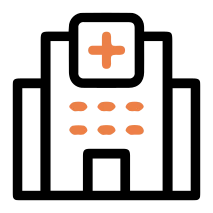Sinusitis in children is a common yet often misunderstood condition. It refers to the inflammation or infection of the sinuses—air-filled spaces within the bones of the face and skull. While adults may describe sinus pain or pressure easily, children often struggle to express what they feel, making it tricky for parents to identify the problem early.
Sinus infections can result from a prolonged cold, allergies, or bacterial infection, and symptoms like nasal congestion, cough, and facial pain may persist for weeks. Understanding the signs of pediatric sinusitis, knowing when to seek help, and exploring the available treatment options are vital steps in managing this condition effectively.
This article will guide parents, teachers, and caregivers through the key aspects of sinusitis in kids using simple language, while also incorporating useful SEO keywords such as “chronic sinusitis in children,” “pediatric sinus infection treatment,” “symptoms of sinusitis in kids,” and “child sinus infection remedies.”
What is Sinusitis in Children?
Sinusitis, also known as rhinosinusitis, is the inflammation or infection of the mucous membranes that line the sinuses. In children, the sinuses are not fully developed at birth, but they start forming and growing during early childhood.
The most commonly affected sinuses in children include:
- Ethmoid sinuses (present at birth)
- Maxillary sinuses (develop around age 2)
- Frontal sinuses (develop around age 6–8)
- Sphenoid sinuses (develop during adolescence)
Sinusitis is typically caused when mucus drainage is blocked, allowing bacteria, viruses, or fungi to grow. This leads to pressure, swelling, and infection.
Causes of Sinusitis in Children
Why Do Kids Get Sinus Infections?
The causes of sinusitis in children are multifactorial. It often begins with a common cold or upper respiratory tract infection (URI) that doesn’t resolve and leads to mucus buildup and inflammation.
Common causes include:
- Viral infections (cold or flu)
- Bacterial infections (after unresolved viral cold)
- Allergies (hay fever, dust mites, pollen)
- Nasal polyps or anatomical issues (e.g., deviated septum)
- Enlarged adenoids
- Frequent exposure to smoke or pollution
- Weakened immune system
In many cases, a viral sinus infection can resolve on its own, but when bacteria take over, symptoms can worsen and persist.
Symptoms of Sinusitis in Children
Recognizing the Signs of Sinus Infections in Kids
The symptoms of sinusitis in kids vary based on the type and duration of the condition. Since young children can’t always describe what’s wrong, it’s essential for parents to be observant.
Acute Sinusitis (Lasts <4 weeks)
- Thick nasal discharge (yellow or green)
- Cough that worsens at night
- Fever
- Facial pain or pressure
- Bad breath
- Irritability or fatigue
- Swelling around the eyes
Chronic Sinusitis (Lasts >12 weeks)
- Persistent nasal congestion
- Ongoing cough
- Postnasal drip
- Loss of smell
- Recurring headaches
- Fatigue and poor school performance
If symptoms last longer than 10 days without improvement, or worsen after initial improvement, a doctor should be consulted.
Types of Sinusitis in Children
Classification Based on Duration
Sinusitis in children is categorized into:
- Acute Sinusitis: Sudden onset, lasting less than 4 weeks
- Subacute Sinusitis: Lasts 4–12 weeks
- Chronic Sinusitis: Lasts more than 12 weeks
- Recurrent Acute Sinusitis: 4 or more episodes per year, each resolving in between
Each type requires a tailored treatment plan, especially chronic cases which may need more intensive evaluation.
Diagnosis of Sinusitis in Children
How Do Doctors Identify It?
Diagnosis of sinusitis in children is usually clinical, based on symptoms and physical examination. Sometimes, additional investigations may be required, especially in chronic or complicated cases.
Diagnostic Tools
- Medical history and physical exam
- Nasal endoscopy: Visual inspection of sinuses using a tiny camera
- Sinus X-ray (less commonly used)
- CT scan of sinuses: Best for detailed imaging in chronic sinusitis
- Allergy testing: If allergic rhinitis is suspected
- Culture of nasal secretions: To identify bacterial cause
Timely diagnosis helps in reducing complications and planning effective treatment.
Treatment of Sinusitis in Children
Medical and Supportive Care Options
The treatment of sinusitis in children depends on whether it is acute or chronic, and whether it’s viral or bacterial.
For Acute Sinusitis (Most Commonly Viral)
- Rest and hydration
- Saline nasal spray or rinse
- Steam inhalation or humidifier
- Nasal decongestants (for short-term use)
- Paracetamol or ibuprofen for pain or fever
For Bacterial Sinusitis
- Antibiotics: Usually amoxicillin or amoxicillin-clavulanate for 10–14 days
- Monitoring: If symptoms don’t improve after 3 days of antibiotics, a review is necessary
For Chronic or Recurrent Sinusitis
- Nasal corticosteroids to reduce inflammation
- Antibiotics for a longer duration
- Allergy management
- Surgical options (adenoidectomy or Functional Endoscopic Sinus Surgery – FESS)
Early intervention and consistent follow-up ensure better recovery and fewer relapses.
Prevention of Sinus Infections in Children
Healthy Habits for Happy Sinuses
You can reduce your child’s risk of sinusitis by:
- Encouraging hand hygiene to prevent colds
- Avoiding secondhand smoke
- Using humidifiers in dry environments
- Keeping children away from sick peers
- Managing allergies with proper medications
- Ensuring timely vaccinations, especially flu shots
Regular health checkups help identify and treat predisposing factors like allergies or adenoid enlargement early on.
Table: Acute vs Chronic Sinusitis in Children
| Feature | Acute Sinusitis | Chronic Sinusitis |
|---|---|---|
| Duration | Less than 4 weeks | More than 12 weeks |
| Common Cause | Viral or bacterial infection | Ongoing inflammation, allergies |
| Symptoms | Fever, cough, nasal discharge | Nasal blockage, postnasal drip, fatigue |
| Pain | Facial pain and pressure | Usually milder or absent |
| Treatment | Supportive care ± short-course antibiotics | Long-term antibiotics, nasal steroids, surgery |
| Need for Imaging | Rare | Often required |
Frequently Asked Questions (FAQs)
What are the first signs that my child may have sinusitis?
The earliest signs of sinusitis in children often resemble a common cold: runny nose, congestion, and mild cough. However, when symptoms persist beyond 10 days or worsen after a brief period of improvement, sinusitis becomes a likely cause. A child may also experience facial pain, pressure near the eyes or forehead, bad breath, and thick green or yellow nasal discharge. Younger children may not articulate discomfort, but may be unusually cranky, have trouble sleeping, or lose interest in food.
Is sinusitis in children contagious?
The infection causing sinusitis—such as a cold or virus—is contagious, but sinusitis itself is not. When your child catches a cold, the inflammation of the nasal passages can block the sinuses, causing mucus buildup and sometimes bacterial infection. It’s this process that leads to sinusitis. The best way to prevent spreading is proper handwashing, avoiding sharing items, and keeping children with colds at home during the initial days.
Can allergies cause sinus infections in children?
Yes, allergies are a major risk factor for sinusitis. When a child is exposed to allergens like pollen, dust, or pet dander, their nasal passages swell and produce more mucus. This creates an ideal environment for bacteria to grow, leading to a sinus infection. Treating allergies with antihistamines, avoiding known triggers, and using nasal corticosteroids can reduce the risk of recurrent sinus infections.
What is the best treatment for sinusitis in kids?
Most sinus infections in children, especially those caused by viruses, resolve on their own with supportive care. Over-the-counter pain relievers, saline sprays, and humidifiers help ease symptoms. If a bacterial infection is suspected—especially when symptoms last more than 10 days or worsen—antibiotics like amoxicillin may be prescribed. Chronic cases may need allergy treatment, longer antibiotic courses, or even minor surgery to open blocked sinuses or remove enlarged adenoids.
How long does a sinus infection last in children?
An acute sinus infection can last anywhere from 10 to 14 days, while symptoms like cough may linger for a few more days. If the infection lasts more than 12 weeks, it’s considered chronic sinusitis. With proper diagnosis and treatment, most children recover fully without complications. For recurrent or chronic cases, further evaluation by an ENT specialist may be necessary to identify underlying causes.
Can sinus infections in children be prevented?
Yes, many sinus infections can be prevented. Ensure your child practices good hygiene, especially handwashing. Keep them away from cigarette smoke and treat allergies early. Ensure they stay hydrated and get enough sleep to support a strong immune system. Using saline nasal sprays during colds and flu season may help prevent sinus blockage. And most importantly, get routine vaccinations, including the flu shot.
Are antibiotics always needed for sinusitis in children?
No, not always. Many sinus infections are viral and clear up without antibiotics. Doctors usually reserve antibiotics for bacterial infections—especially when symptoms persist beyond 10 days, get worse after improving, or are severe from the start (e.g., high fever, facial pain). Overusing antibiotics can lead to resistance, so it’s important to let the doctor decide if they’re necessary.
Can sinusitis cause complications in kids if left untreated?
Yes, though rare, untreated sinusitis can lead to complications like orbital cellulitis (eye socket infection), abscess formation, or spread to the brain (meningitis). Chronic untreated infections can also affect quality of life, leading to poor sleep, reduced appetite, and school absences. That’s why persistent or worsening symptoms should not be ignored, and a doctor’s opinion must be sought.
How is chronic sinusitis different from allergies in children?
Both can cause similar symptoms like nasal congestion and postnasal drip. However, chronic sinusitis includes thick discharge, facial pain, and cough lasting more than 12 weeks. Allergies are usually triggered by environmental factors and include itchy eyes, sneezing, and clear nasal drainage. Allergy tests and imaging can help distinguish between the two, and sometimes, both conditions coexist and worsen each other.
When should a child see an ENT specialist for sinus problems?
If your child has frequent sinus infections (more than 4 per year), chronic symptoms despite treatment, or complications like swollen eyes or vision issues, a referral to an ENT (Ear, Nose, and Throat) specialist is necessary. The ENT may recommend imaging, allergy testing, or surgical procedures like adenoid removal or sinus surgery to provide long-term relief.
Research References on Sinusitis in Children
| Title of Study | Author Name |
|---|---|
| Clinical Guidelines for Pediatric Sinusitis | Dr. Maya Khandelwal |
| Role of Allergies in Recurrent Sinusitis in Children | Dr. Arjun Menon |
| Nasal Endoscopy in Diagnosis of Pediatric Chronic Sinusitis | Dr. Shruti Kapoor |
| Comparing Antibiotics in Pediatric Acute Rhinosinusitis | Dr. Harsh Verma |
| Saline Irrigation as a Supportive Therapy | Dr. Reema Seth |
| Adenoidectomy in Chronic Sinusitis Management | Dr. Vikram Sahni |
| Pediatric CT Findings in Chronic Sinusitis | Dr. Kavita Iyer |
| Impact of Environmental Factors on Pediatric Sinusitis | Dr. Neha Bansal |
| Role of Corticosteroids in Treating Sinus Inflammation | Dr. Sanjay Joshi |
| Management Strategies for Recurrent Pediatric Sinusitis | Dr. Sheetal Narula |






 and then
and then